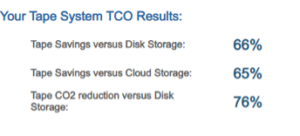LTO-9 Serves the Needs of Enterprise Environments and Large Organizations like CERN
By Drew Robb, Guest Blogger

The recent release of LTO-9 makes it clear that LTO tape serves the needs of enterprise environments. The cloud hyperscalers and many large organizations are firm believers in LTO tape as the best medium for large-scale storage and archiving.
Despite only being released in early September, tape drives and systems are now available for LTO-9 from the likes of IBM, Quantum, and Spectra Logic. On the media side, companies such as Fujifilm and Sony have launched LTO-9 tape cartridges.
LTO-9 Delivers Capacity and Performance
Fujifilm’s LTO Ultrium 9 data cartridge, for example, offers up to 45 TB of storage capacity (18 TB for non-compressed data), a 50% increase from the previous generation of LTO-8. The boost in storage capacity is achieved using Barium Ferrite (BaFe) magnetic particles, formulated into fine particles with Fujifilm’s Nanocubic technology that evenly distributes the magnetic particles on the tape surface, forming a smooth and thin magnetic layer for improved read/write performance. LTO-9 also delivers high-speed data transfer reaching up to 1,000MB/sec. for compressed data (400MB/sec. native), a 25% increase over LTO-8.
LTO-9 Deployment at CERN
I recently had the opportunity to interview Vladimir Bahyl, a beta LTO-9 user at world-renowned CERN. Vladimir, who is in charge of data archiving at CERN is now rolling out LTO-9 within his storage environment. This is where data from the Large Hadron Collider (LHC) is stored. Massive amounts of data have been generated to date in experiments using a particle collider that measures 17 miles in circumference and is located roughly 100 meters below the France–Switzerland border. Tape has been in use at CERN for about five decades, and the organization currently stores around 400 PB on tape. This enables CERN to keep pace with the data explosion.
After a three-year break for upgrades, the collider is about to recommence operation. The IT department expects up to 180 PB of data to be added in 2022. CERN can cope with that quantity of information courtesy of a sophisticated tape-disk-SSD architecture. All results and all raw data from all CERN experiments are stored on tape and archived. When anything needs to be analyzed, it is transferred to disk and SSD.
Leveraging oRAO for Enhanced Access Time
A feature known as Open Recommended Access Order (oRAO) was included in LTO media for the first time with LTO-9. oRAO enables the retrieval of tape content in a more efficient way. Instead of sequentially laying out data on tape, oRAO takes advantage of multiple serpentine tracks on one tape to arrange data for more rapid access. According to testing at CERN, oRAO can position tape for data access anywhere from 30% to 70% faster than traditional sequential tape. What this adds up to is the need for fewer tape drives for the data recall workflow. If more backup vendors adopt this technology, it could seriously reduce the time needed for a restore.
Benefits of Tape at CERN
Users such as CERN gravitate toward tape for many reasons. In terms of long-term stability, data can still be recovered from tape after 30 years, whereas hard drives struggle to retain data beyond five years. Tape reliability is higher too. CERN has dozens of hard drives failing every week (out of tens of thousands it has on-site) compared to a negligible failure rate for tape.
But economics certainly factor in. Tape brings big savings in terms of CAPEX and OPEX. From an operating expense standpoint, tape consumes no power while tape cartridges are sitting idle, so it’s cost-effective and eco-friendly. The most cost-effective technology for large-scale, long-term storage is tape. And as it offers an air gap, to thwart online hackers, it raises the level of security.
In terms of reliability, the Fujifilm tape used at CERN performed well during a recent tape repacking project to switch older cartridges to the latest tape generation format. Out of 100 PB of tape that was read and repacked (6,300 miles of physical media), only 5 GB (3.5 feet) of data was corrupted – but even those files were recovered soon after.
You can find out more about CERN’s innovative implementation of tape at the upcoming 12th Annual Fujifilm Global IT Executive Summit in San Diego, June 22-24, 2022.
LTO Specs:
| Maximum capacity | 45TB compressed (18TB native) |
| Maximum transfer rate | 1,000MB/sec. compressed (400MB/sec. native) |
| Number of tracks | 8,960 (32 track heads in the serpentine format) |
| Cartridge memory | Internal EEPROM with 32kB electromagnetic induction antenna |
| Tape width | 12.65 mm |
| Tape thickness | 5.2 μm |
| Tape length per cartridge | 1,035 m |


